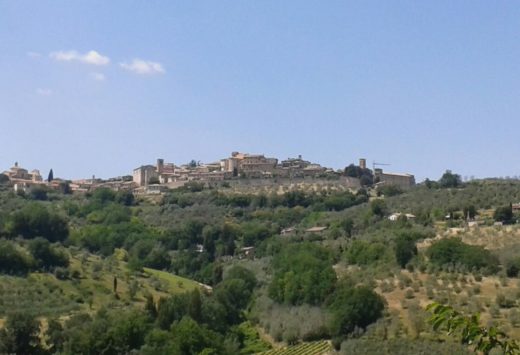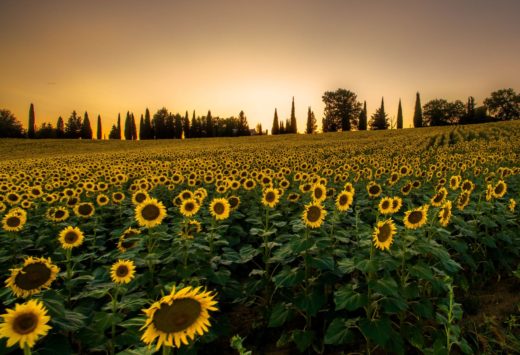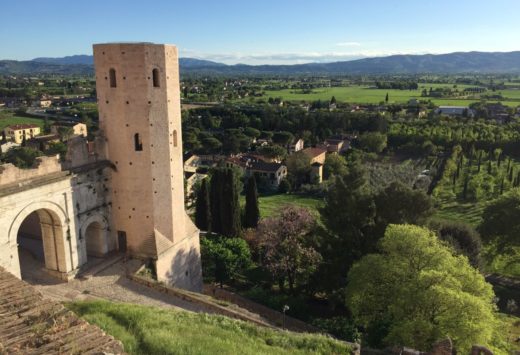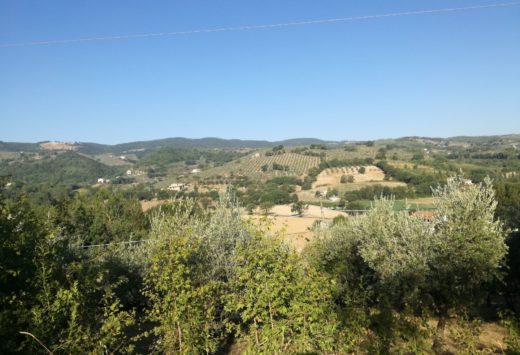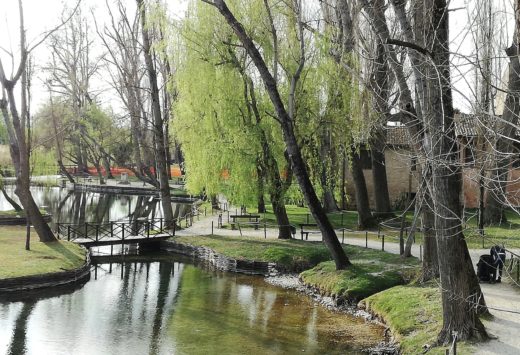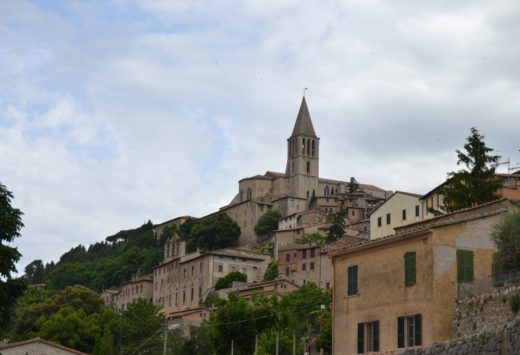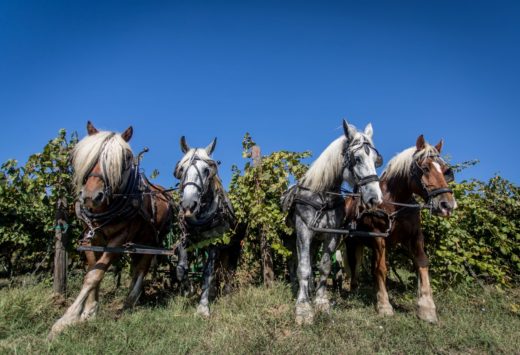Discover Montefalco, the home of Sagrantino and of art.
Perched on a hill surrounded by a lush tapestry of vineyards and olive groves, the enchanting town of Montefalco dominates the entire Umbrian Valley: its enviable position in 1568 earned it the nickname ‘Ringhiera dell’Umbria’ meaning the ‘Balcony of Umbria’. Indeed, the views that can be admired from its Belvedere are truly breath-taking, stretching out as far as the eye can see over the Clitunno, Topino and Tiber valleys; Foligno, Spello, Assisi and Perugia – which is about 50 km from the town – are just some of the cities that can be identified, together with the peaks of the Apennines, Subasio and Martani mountains.
The history of Montefalco dates way back in time. There are numerous traces that suggest it was already inhabited at the time of the ancient Umbrians. In Roman times, numerous patrician villas were built on the hill and in the surrounding areas, which were part of the municipality of Mevania (Bevagna). They were the cradle of the future inhabited centre.
After the fall of the Roman Empire, the Lombard invaders fortified the numerous hillside settlements to turn them into the headquarters of their ‘courts’. One of these courts, built around the parish church built on the sepulchre of San Fortunato, evangelizer of the area, was Montefalco with its ancient name of Coccorone. The origins of this name are uncertain. Some scholars believe it might derive from the Roman senator Marco Curione, who had possessions in the area, while others believe it is connected to the Greek word oros (mountain).
During the early Middle Ages, the nearby Duchy of Spoleto conquered the town, allowing it, however, to remain a free municipality. It thus had its own statute and was ruled in the 12th and early part of the 13th centuries by consuls and then by figures akin to a chief magistrate. It succeeded in maintaining a fair degree of autonomy and achieved its own clear identity. It later became an influential arts centre and an important site for wine and oil production.
In this period five gates or gateways (Santa Maria, San Lorenzo, San Clemente, Camiano and San Bartolomeo) marked the boundary of the inhabited centre. The same gates were connected by mighty walls to defend the town that developed around the circular square, on top of the hill on which the Palazzo Comunale was built. Numerous churches were built within the first town walls, including Sant’Agostino with its convent, which was erected on the remains of a pre-existing building perhaps consecrated to San Giovanni Battista.
In the first decades of the 13th century, a second perimeter wall was built to incorporate the populous towns of Colla Mora and Castellare. Over time, respectively, they built up beyond the gateways of San Clemente and Santa Maria. Following these fortification works, two other entrance gates to the town were built: Porta della Rocca and Porta Sant’Agostino, which are still visible.
In 1249 Coccorone changed its name to Montefalco. This was probably determined by Emperor Frederick II of Swabia, a great lover of hawks, who found significant numbers in the area. Montefalco was then the seat of the ducal curia of Spoleto during the Pope’s exile in Avignon (1320-1355). The town hosted the famous architect and sculptor Lorenzo Maitani (who created the splendid facade of Orvieto’s Cathedral) with the aim of restoring the town’s ancient fortifications. Starting from this period and throughout the following century, Montefalco was an important centre for the arts.
It was the Franciscan friars who first commissioned and thus attracted the major artists of the time. The town became the focal point for the expansion of painterly movements that were crucial for the evolution of Umbrian art. The beautiful frescoes that Benozzo Gozzoli created inside the church of San Francesco (now a museum), the frescoes of the Umbrian-Sienese school in the chapel of Santa Croce inside the church of Santa Chiara, and the frescoes by Melanzio in the church of Santa Maria di Piazza date back to this period.
After a rather short period (1383-1489) which brought Montefalco under the control, on various occasions, of the Trinci family of Foligno, the town reverted definitively to the Papal States. It then experienced its most prosperous period, under the governor Nicolò Maurizi da Tolentino.
This prosperous time, however, came to an abrupt and violent end. In 1527, on charges of treason, the notorious Bande Nere (‘Black Bands’) led by Orazio Baglioni, invaded and sacked the town. They occupied it for more than a month, also causing serious plagues that exhausted the population and blighted its artistic and economic activities. It was not until 1848 that Montefalco, after having annexed the castles of Fratta and San Luca to its territories, would obtain the title of town from the Papal States, then governed by Pope Pius IX.
Montefalco is home to eight saints, above all Santa Chiara della Croce, whose life is inextricably intertwined with that of her town; the painter Francesco Melanzio, pupil of Perugino, and cardinal Giovanni Domenico de Cuppis were also born here. Furthermore, the Swabian emperors Frederick Barbarossa and Frederick II were hosted there; after the latter’s arrival in the town, Porta di San Bartolomeo then took the name of the sovereign. This gate, together with the three gates of Camiano, della Rocca and Verziere, has survived to this day.
Montefalco cannot be named without talking about its wine: Sagrantino, a dry and harmonious DOCG red wine that is renowned all over the world. The best way to taste it is to try it accompanied by other typical local products, such as game, or with first courses made with Sagrantino, such as gnocchi and pappardelle. Together with the Municipalities of Giano dell’Umbria, Gualdo Cattaneo, Bevagna and Castel Ritaldi, Montefalco is part of the ‘Strada del Sagrantino’, a food and wine route aimed at enhancing the acclaimed red wine. Another of the area’s gems is its extra virgin olive oil, designated Colli Martani Dop.
You can taste products that are typical of the Sagrantino area throughout the year: there is, in fact, a Market-cum-Fair held during Easter week, or the initiative called Cantine Aperte, an open day for wine lovers and the general public held by wineries in May; in September the Settimana Enologica (Wine Week) is held, when gastronomic delights are linked to nature via numerous excursions around the town. The Festa della Vendemmia (Harvest Festival) is also held in the same month, while in November, oil is celebrated at the oils mills’ open day called Frantoi Aperti. Montefalco in summer is also a treasure trove of fun and entertainment: August 17th is the Feast of Santa Chiara, while ‘Agosto Montefalchese’ includes a rich three-week programme of events, the heart of which is the challenge between the four districts of the town for the Falco D’Oro (Golden Falcon) award: there are competitions between drummers, flag-wavers and musicians, crossbowmen and theatrical performances. It all ends with the ‘Fuga del Bove’, a bull race at the ‘Campo dei Giochi’.



